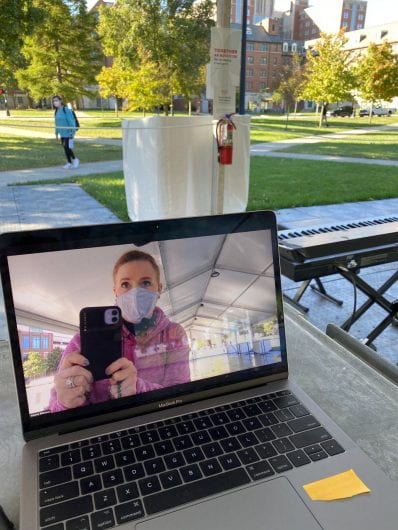
Three dance students, Carter Smyke, Arie Vasquez, and Rachel Waid (left to right) demonstrate for ballet classes with pianist Phil DuPont. Credit: Courtesy of Valarie Williams
With the virtual return to classes, some education does not translate as easily to online platforms as others. However, performing arts educators have used their creativity to implement safety measures and continue their primarily hands-on education.
Eugenia Costa-Giomi, the interim director of the School of Music, said that the school has made an effort to move most courses online, but they have developed safe procedures and opportunities to provide in-person connection for students.
For wind ensembles, students rehearse for no more than an hour, maintain a distance of 10 feet, bring their own music stands and material, and use face masks and bell covers to reduce the spread of aerosols out of their instruments. Vocal lessons and choirs are not permitted in the building, but Costa-Giomi said the instructors have been persistent in trying to get around the troubles of teaching over Zoom.
“Teaching a voice lesson over Zoom — with all the problems of synchrony and the nuances in the loudness of the sound and the quality of the tone — those are things that we have to thank our instructors for being so resourceful and creative and the students for being so patient and persistent and determined to make this work,” Costa-Giomi said.
Practicing is an important part of the process for musicians. Costa-Giomi said the school has safely made practice rooms available for students by implementing a sign-up system, room monitors and letting the room air out for 15 minutes between performers to decrease potential time for airborne transmission.

The Department of Dance has created a projection system used to let professors teach students simultaneously in two different studios and Zoom. Credit: Courtesy of Valarie Williams
Valarie Williams, a professor in the Department of Dance, said the department has put forth tremendous efforts to allow for in-person instruction. With cameras, sound mixers, projectors, microphones and Zoom, Williams was able to simultaneously instruct two in-person sections and a handful of virtual participants from one studio.
Additionally, Williams said the department has implemented a virtual option for each course so that students in quarantine can get instruction tailored to them through the online medium, instead of having to join an in-person class via Zoom.
Sherée Greco, the production manager for the Department of Theatre, Film, and Media Arts, said the department has enforced rules such as a mask mandate at all times inside the building, 6-foot distancing between actors and 30-minute breaks after each hour of rehearsal to decrease exposure.
In an effort to provide as many production opportunities as possible for students during a challenging time, Greco said the department has added many new projects to their season. These new opportunities include Master of Fine Arts students designing set and costume installations that undergraduate students will then construct, a Zoom production of “Collective Rage: A Play in Five Betties,” a radioplay and a new spin on the annual DigiEye event, an evening of original live action and animated moving image short films created by students.
“This year, in order to avoid an audience in an indoor theatre, DigiEYE is set to be projected onto the Drake building exterior for an outdoor film experience,” Greco said.
Williams said new opportunities such as completely asynchronous classes, outdoor performances, and a project where performers are filmed individually and the clips are spliced together to create a full piece, have been a good challenge for students.
“You feel the embodiment of what you’re doing and the dancers are thinking in new and different ways,” Williams said. “So it’s been a real benefit from the unbelievable mess of the pandemic.”
Costa-Giomi said the School of Music typically has 150 recitals per semester, and even though they continue to perform virtually, the lack of in-person performance has been shocking.
“In performance, we have this great combination of all the time we spend alone mastering our craft. We do it alone for hours every day, but then the purpose of all that is to make music together and for others,” Costa-Giomi said. “So we continue to do it alone, but it’s so difficult not to be able to do it together, so that balance is broken.”

Valarie Williams, a professor in the Department of Dance, sets up tents for dance class in fall 2020. Credit: Courtesy of Valarie Williams
In order to help students find determination in their craft, Williams said she likes to emphasize the difference between the presence students have when they are in the studio and the presence they have when they are one of 25 squares on Zoom.
“I think that students are understanding the embodiment of what we’re asking them to do in a different way because they have to connect with another person through a very different medium and sometimes across several miles and sometimes across four time zones,” Williams said. “I think this determination, the idea of embodiment, the idea of presence and how that changes in different mediums is really beneficial to students.”
Although the pandemic has caused some challenges, Williams said there are some things that she would like to continue implementing into her instruction once the pandemic is under control, such as allowing students to join class over Zoom if they are injured or ill.
“You can learn a lot by watching and reflecting,” Williams said. “Sometimes it’s good to step back and watch what other people are doing. You listen differently.”


